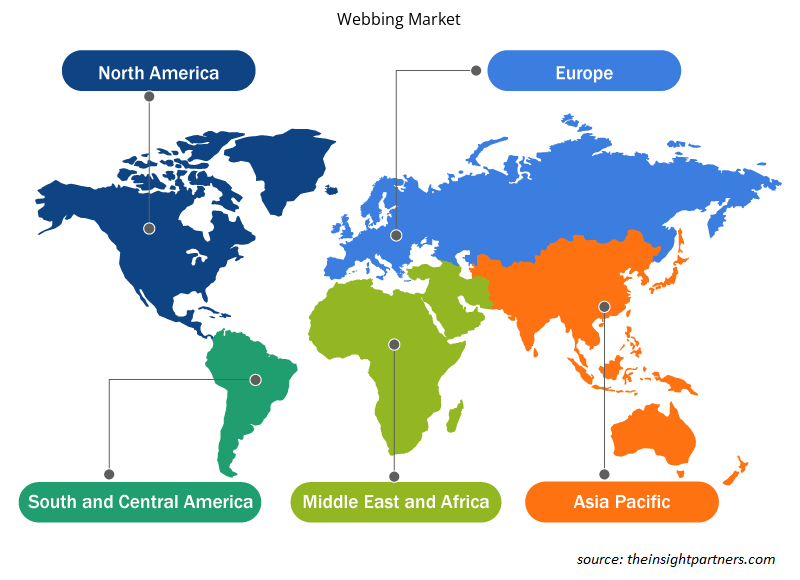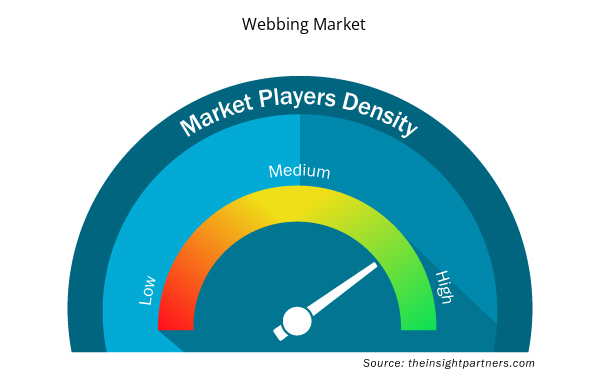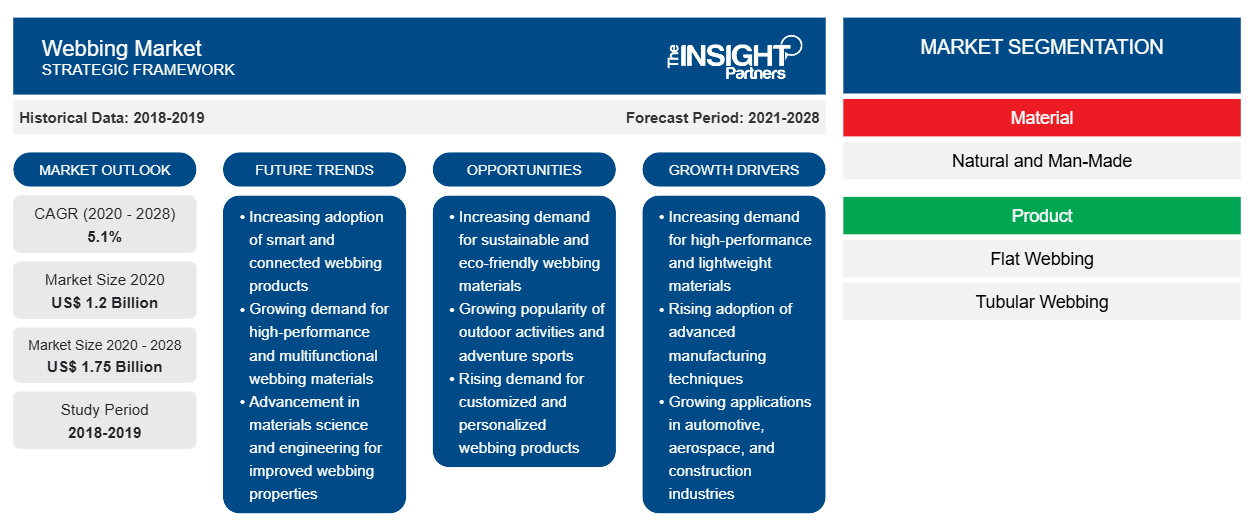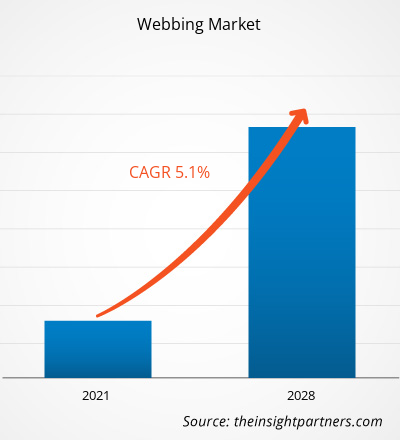预计到 2028 年,织带市场规模将从 2020 年的 11.9535 亿美元增至 17.4584 亿美元;预计从 2021 年到 2028 年,复合年增长率为5.1%。
织带是一种坚固的编织纤维,有扁平条状或管状两种形式,可用作绳索的替代品。传统上,织带是用棉和丝制成的,但聚合物、尼龙和聚酯正在取代传统材料。织带以其便利性、抗拉强度和耐化学性等特性而闻名;它可用作各种工业应用中的钢丝、绳索或链条的替代品。织带广泛应用于军用服装、降落伞、登山、汽车纺织品、消防安全装备、军用物品、安全带、背包、远足装备等。除此之外,织带还广泛用于生产石油和天然气工人的防护设备。
2021 年,按最终用途划分,汽车行业将占据全球织带市场的最大份额。织带是制造安全带、安全带、拉带、敞篷车顶边缘绑带、行李网带和绑带、安全气囊安全带等的重要组成部分。印度和中国等发展中经济体对汽车的需求增长正在支持市场的增长。根据《全球道路安全状况报告》,佩戴安全带以最大限度地降低前排乘客和后排乘客死亡风险的重要性和意识日益增强,这推动了对织带的需求。
2021 年,亚太地区将占据全球织带市场的最大份额。该地区在全球市场的主导地位主要归功于强大的工业部门,包括几家知名企业的制造部门。汽车、航空航天和国防、工业和安全、时尚配饰、纺织和体育用品等垂直行业对织带的需求很高。此外,制造业投资的增加为亚太地区织带市场的增长提供了丰厚的机会。印度政府实施的“自力更生印度计划”和“印度制造”等优惠政策预计将为多元化的工业基础创造足够的增长机会,进而将促进该地区织带的消费。
定制此报告以满足您的需求
您可以免费定制任何报告,包括本报告的部分内容、国家级分析、Excel 数据包,以及为初创企业和大学提供优惠和折扣
- 获取此报告的关键市场趋势。这个免费样品将包括数据分析,从市场趋势到估计和预测。
COVID-19 疫情对织带市场的影响
截至 2021 年 6 月,美国、印度、巴西、俄罗斯、英国、法国、西班牙、意大利、土耳其、德国、哥伦比亚和阿根廷是受 COVID-19 疫情影响最严重的国家。为遏制疾病传播而采取的措施,包括封锁、旅行禁令和企业停业,严重影响了多个国家的经济和行业。化学品和材料是因供应链和工厂运营中断而遭受严重破坏的关键行业之一。北美、欧洲和亚太地区等地区制造工厂的关闭阻碍了全球供应链,从而影响了制造流程、配送计划和产品销售。COVID-19 疫情的后果还导致织带生产、需求和贸易放缓。国家和国际边界的关闭影响了各公司的业务发展战略。然而,随着各经济体计划恢复运营、放松封锁措施并开展大规模疫苗接种活动,织带市场可能会在未来几个月内反弹。
市场洞察
人造织带需求增长显著促进织带市场增长
与天然织带材料相比,人造织带的需求增长显著。芳族聚酰胺纤维、聚苯并恶唑、聚酯、聚丙烯和尼龙是织带中使用的几种人造合成材料。聚酯以其各种出色的特性而闻名,例如高抗拉强度、耐水、耐磨和抗紫外线老化、易于维护以及耐水、耐磨和抗紫外线辐射、拉伸和收缩、耐性和耐化学性。因此,在其他类型的人造织带材料中,聚酯基织带的使用范围已扩展到各种应用领域,例如船用织物应用、包把手、帆索和支撑带。此外,由合成聚酯(纤维材料)制成的吊索比钢丝绳和链条吊索重量更轻。除聚酯外,尼龙的需求量很大,因为它比其他材料具有更好的弹性。尼龙织带正被广泛使用。这种特性使其可用于多种终端应用,如安全气囊、安全带、安全带和行李网等。此外,碳纤维还具有多种显著特性,如热膨胀有限、耐受极端温度条件、耐化学性、高抗拉强度、重量轻、抗拉强度高,这些特性使其成为理想的织带材料。碳纤维织带用于军事和体育用品。
材料洞察
根据材料,织带市场分为天然织带和人造织带。就收入份额而言,人造织带目前占据市场主导地位。该领域的市场增长归功于织带生产中使用的人造材料价格较低且供应更充足。这些材料包括聚酯、尼龙、聚丙烯、芳纶纤维、聚苯并恶唑、液晶聚合物纱和高模量聚乙烯。聚酯织带通常用于需要低到高承载能力的应用中。由于其出色的抗褪色性,聚酯织带越来越多地用于海上织物应用,例如支撑带、帆带和包把手。此外,聚酯还以其快干、易清洁、高拉伸强度以及抗紫外线劣化、防水、耐磨、拉伸、收缩、化学暴露和霉菌生长等优异性能而闻名。
产品洞察
根据产品,织带市场分为扁平织带、管状织带和其他产品。就收入份额而言,扁平织带部分目前占据市场主导地位。扁平织带通常称为扁平绳,由坚固编织的纤维制成,具有各种厚度和宽度。扁平织带在可以将材料编织成较大产品的应用中效果很好,例如背包带、安全带和加固绑带。它通常比管状纺织品更硬。
最终用途洞察
根据最终用途,织带市场细分为航空航天、汽车、军事、工业和安全、时尚配饰、电子纺织品、体育用品、船舶、医疗等。就收入份额而言,航空航天部门目前占据市场主导地位。织带的开发和使用彻底改变了航空航天工业。编织织带的高性能和低重量等特点有助于满足适用于航空航天工业的严格行业标准。编织织带还为航空航天应用带来了耐热、耐化学腐蚀和耐磨以及易于清洁等优点。此外,专用窄带织物、2D 和 3D热固性材料、热塑性织物和新型电子织带适合满足行业的特定强度要求。此外,这些材料广泛用于关键的航空航天应用,如降落伞、货物约束系统和座椅,以及一些内部应用,如机组安全系统组件、飞行服、气垫滑梯、安全带和漂浮装置。
织带市场的一些主要关键参与者包括 American Cord & Webbing Co, Inc.;Belt-tech;E. Oppermann GmbH;Narrowtex Australia;和 National Webbing Products Co. 这些市场参与者高度注重高质量和创新产品的开发。
报告亮点
- 织带行业发展趋势助力参与者制定有效的长期战略
- 发达市场和发展中市场织带市场参与者采用的业务增长战略
- 2019 年至 2028 年市场定量分析
- 全球织带需求量估计
- PEST 分析可说明行业内买家和供应商的效率
- 了解竞争市场状况的最新发展
- 市场趋势和前景以及推动和制约织带市场增长的因素
- 通过强调支撑商业利益的市场策略来协助决策过程,从而促进市场增长
- 市场的详细概述和细分,以及织带行业动态
- 各地区织带市场规模及增长潜力
织带市场区域洞察
Insight Partners 的分析师已详尽解释了预测期内影响织带市场的区域趋势和因素。本节还讨论了北美、欧洲、亚太地区、中东和非洲以及南美和中美洲的织带市场细分和地理位置。

- 获取织带市场的区域特定数据
织带市场报告范围
| 报告属性 | 细节 |
|---|---|
| 2020 年市场规模 | 12亿美元 |
| 2028 年市场规模 | 17.5亿美元 |
| 全球复合年增长率(2020 - 2028) | 5.1% |
| 史料 | 2018-2019 |
| 预测期 | 2021-2028 |
| 涵盖的领域 | 按材质
|
| 覆盖地区和国家 | 北美
|
| 市场领导者和主要公司简介 |
|
织带市场参与者密度:了解其对业务动态的影响
织带市场正在快速增长,这得益于终端用户需求的不断增长,而这些需求又源于消费者偏好的不断变化、技术进步以及对产品优势的认识不断提高等因素。随着需求的增加,企业正在扩大其产品范围,进行创新以满足消费者的需求,并利用新兴趋势,从而进一步推动市场增长。
市场参与者密度是指在特定市场或行业内运营的企业或公司的分布情况。它表明在给定市场空间中,相对于其规模或总市场价值,有多少竞争对手(市场参与者)存在。
在织带市场运营的主要公司有:
- 美国线带织带有限公司
- 巴利带状磨坊
- 皮带技术
- E. OPPERMANN 有限公司
- MURDOCK 织带公司
免责声明:上面列出的公司没有按照任何特定顺序排列。

- 获取织带市场顶级关键参与者概述
织带市场,按材料分类
- 自然的
- 人造
织带市场(按产品分类)
- 扁平织带
- 管状织带
- 其他的
织带市场(按产品分类)
- 航天
- 汽车
- 军队
- 工业和安全
- 时尚配饰
- 电子纺织
- 体育用品
- 海洋
- 医疗的
- 其他的
公司简介
- 美国线绳与织带有限公司
- 巴利带式磨坊
- 皮带技术
- E. Oppermann 有限公司
- 默多克织带公司
- 澳大利亚 Narrowtex
- 国家织带制品公司
- 俄亥俄塑料输送带公司
- 织带公司
- 田纳西织带产品
- 历史分析(2 年)、基准年、预测(7 年)及复合年增长率
- PEST 和 SWOT 分析
- 市场规模价值/数量 - 全球、区域、国家
- 行业和竞争格局
- Excel 数据集



Report Coverage
Revenue forecast, Company Analysis, Industry landscape, Growth factors, and Trends

Segment Covered
This text is related
to segments covered.

Regional Scope
North America, Europe, Asia Pacific, Middle East & Africa, South & Central America

Country Scope
This text is related
to country scope.
常见问题
Automotive segment held the largest share in the global webbing market in 2020. Webbing is significantly used in preparation of production of seat belts, safety harnesses, pull straps, edge binding for convertible tops, straps and binding for luggage nets, catch belts for airbags and other such products in automotive industry. Rise in demand for vehicles in developing economies such as India and China are expected to proliferate the growth of the market. For instance, according to Global status report on road safety, the rising focus towards wearing a seatbelt to minimize the risk of a fatality among front seat passengers and rear-seat passengers has promoted the demand for webbing. Additionally, the significant growth in automotive industry is expected to complement the growth of webbing market.
The major players operating in the global webbing market are H AMERICAN CORD & WEBBING CO., INC.; BALLY RIBBON MILLS; BELT-TECH; E. OPPERMANN GMBH; MURDOCK WEBBING COMPANY, INC.; NARROWTEX AUSTRALIA; NATIONAL WEBBING PRODUCTS CO.; OHIO PLASTICS BELTING CO.; RIBBON WEBBING CORP; TENNESSEE WEBBING PRODUCTS; and among others.
In 2020, Asia Pacific contributed to the largest share in the global webbing market. The dominance of the webbing market in this region is primarily attributable to the presence of strong industrial base with prominent manufactures significantly contributing to market growth. High demand of webbing from applications such as automotive, aerospace and defense, industrial and safety, fashion accessories, textile, sport goods and other industries backed by significant growth in end-use industrial bases is stimulating the demand for webbing in regional market. The rise in investment in manufacturing sector across economies further, provides lucrative opportunities for the growth of the webbing market in Asia Pacific.
Trends and growth analysis reports related to Chemicals and Materials : READ MORE..
The List of Companies - Webbing Market
- AMERICAN CORD & WEBBING CO., INC
- BALLY RIBBON MILLS
- BELT-TECH
- E. OPPERMANN GMBH
- MURDOCK WEBBING COMPANY, INC.
- NARROWTEX AUSTRALIA
- NATIONAL WEBBING PRODUCTS CO.
- OHIO PLASTICS BELTING CO.
- RIBBON WEBBING CORP
- TENNESSEE WEBBING PRODUCTS
The Insight Partners performs research in 4 major stages: Data Collection & Secondary Research, Primary Research, Data Analysis and Data Triangulation & Final Review.
- Data Collection and Secondary Research:
As a market research and consulting firm operating from a decade, we have published and advised several client across the globe. First step for any study will start with an assessment of currently available data and insights from existing reports. Further, historical and current market information is collected from Investor Presentations, Annual Reports, SEC Filings, etc., and other information related to company’s performance and market positioning are gathered from Paid Databases (Factiva, Hoovers, and Reuters) and various other publications available in public domain.
Several associations trade associates, technical forums, institutes, societies and organization are accessed to gain technical as well as market related insights through their publications such as research papers, blogs and press releases related to the studies are referred to get cues about the market. Further, white papers, journals, magazines, and other news articles published in last 3 years are scrutinized and analyzed to understand the current market trends.
- Primary Research:
The primarily interview analysis comprise of data obtained from industry participants interview and answers to survey questions gathered by in-house primary team.
For primary research, interviews are conducted with industry experts/CEOs/Marketing Managers/VPs/Subject Matter Experts from both demand and supply side to get a 360-degree view of the market. The primary team conducts several interviews based on the complexity of the markets to understand the various market trends and dynamics which makes research more credible and precise.
A typical research interview fulfils the following functions:
- Provides first-hand information on the market size, market trends, growth trends, competitive landscape, and outlook
- Validates and strengthens in-house secondary research findings
- Develops the analysis team’s expertise and market understanding
Primary research involves email interactions and telephone interviews for each market, category, segment, and sub-segment across geographies. The participants who typically take part in such a process include, but are not limited to:
- Industry participants: VPs, business development managers, market intelligence managers and national sales managers
- Outside experts: Valuation experts, research analysts and key opinion leaders specializing in the electronics and semiconductor industry.
Below is the breakup of our primary respondents by company, designation, and region:

Once we receive the confirmation from primary research sources or primary respondents, we finalize the base year market estimation and forecast the data as per the macroeconomic and microeconomic factors assessed during data collection.
- Data Analysis:
Once data is validated through both secondary as well as primary respondents, we finalize the market estimations by hypothesis formulation and factor analysis at regional and country level.
- Macro-Economic Factor Analysis:
We analyse macroeconomic indicators such the gross domestic product (GDP), increase in the demand for goods and services across industries, technological advancement, regional economic growth, governmental policies, the influence of COVID-19, PEST analysis, and other aspects. This analysis aids in setting benchmarks for various nations/regions and approximating market splits. Additionally, the general trend of the aforementioned components aid in determining the market's development possibilities.
- Country Level Data:
Various factors that are especially aligned to the country are taken into account to determine the market size for a certain area and country, including the presence of vendors, such as headquarters and offices, the country's GDP, demand patterns, and industry growth. To comprehend the market dynamics for the nation, a number of growth variables, inhibitors, application areas, and current market trends are researched. The aforementioned elements aid in determining the country's overall market's growth potential.
- Company Profile:
The “Table of Contents” is formulated by listing and analyzing more than 25 - 30 companies operating in the market ecosystem across geographies. However, we profile only 10 companies as a standard practice in our syndicate reports. These 10 companies comprise leading, emerging, and regional players. Nonetheless, our analysis is not restricted to the 10 listed companies, we also analyze other companies present in the market to develop a holistic view and understand the prevailing trends. The “Company Profiles” section in the report covers key facts, business description, products & services, financial information, SWOT analysis, and key developments. The financial information presented is extracted from the annual reports and official documents of the publicly listed companies. Upon collecting the information for the sections of respective companies, we verify them via various primary sources and then compile the data in respective company profiles. The company level information helps us in deriving the base number as well as in forecasting the market size.
- Developing Base Number:
Aggregation of sales statistics (2020-2022) and macro-economic factor, and other secondary and primary research insights are utilized to arrive at base number and related market shares for 2022. The data gaps are identified in this step and relevant market data is analyzed, collected from paid primary interviews or databases. On finalizing the base year market size, forecasts are developed on the basis of macro-economic, industry and market growth factors and company level analysis.
- Data Triangulation and Final Review:
The market findings and base year market size calculations are validated from supply as well as demand side. Demand side validations are based on macro-economic factor analysis and benchmarks for respective regions and countries. In case of supply side validations, revenues of major companies are estimated (in case not available) based on industry benchmark, approximate number of employees, product portfolio, and primary interviews revenues are gathered. Further revenue from target product/service segment is assessed to avoid overshooting of market statistics. In case of heavy deviations between supply and demand side values, all thes steps are repeated to achieve synchronization.
We follow an iterative model, wherein we share our research findings with Subject Matter Experts (SME’s) and Key Opinion Leaders (KOLs) until consensus view of the market is not formulated – this model negates any drastic deviation in the opinions of experts. Only validated and universally acceptable research findings are quoted in our reports.
We have important check points that we use to validate our research findings – which we call – data triangulation, where we validate the information, we generate from secondary sources with primary interviews and then we re-validate with our internal data bases and Subject matter experts. This comprehensive model enables us to deliver high quality, reliable data in shortest possible time.


 获取此报告的免费样本
获取此报告的免费样本